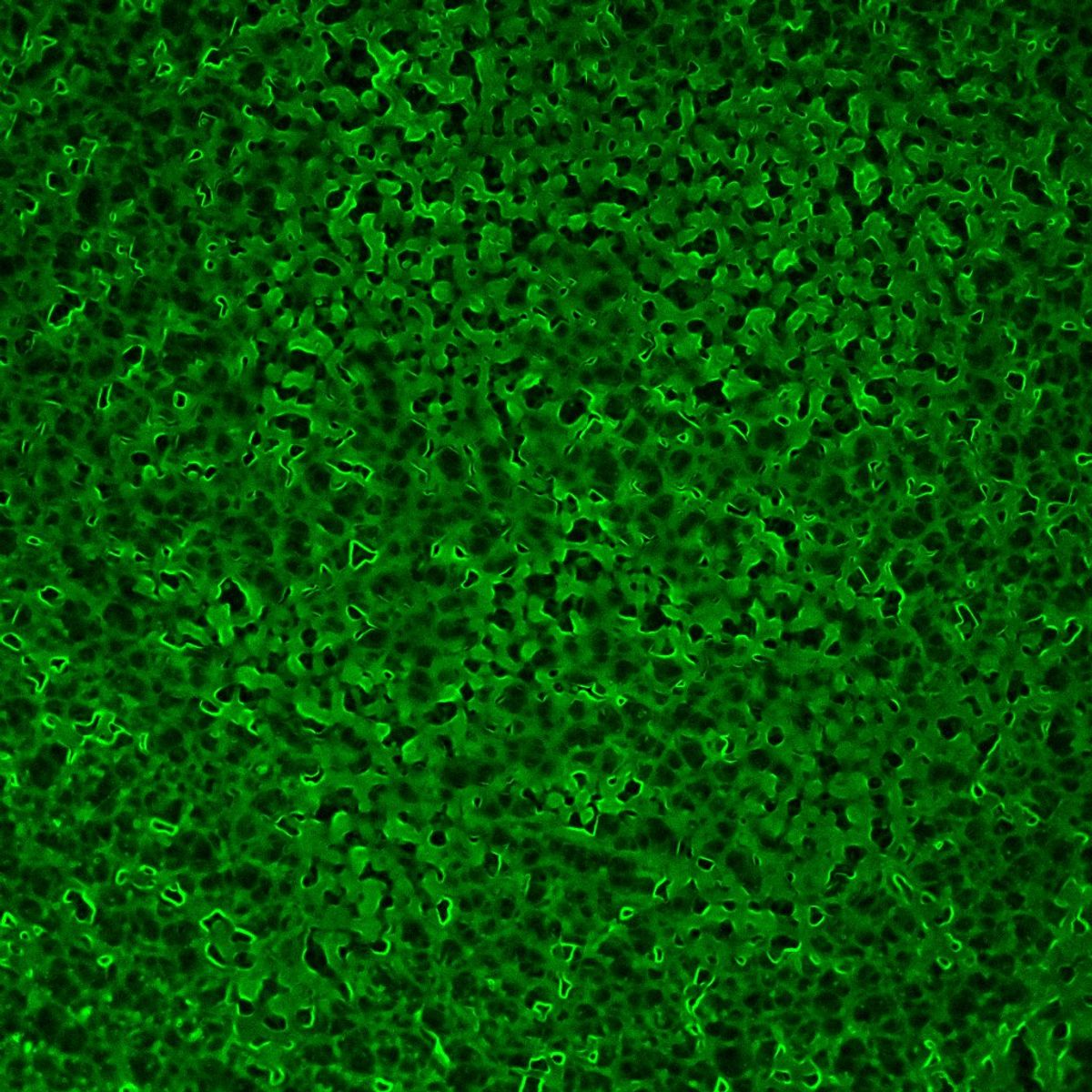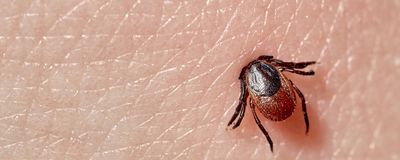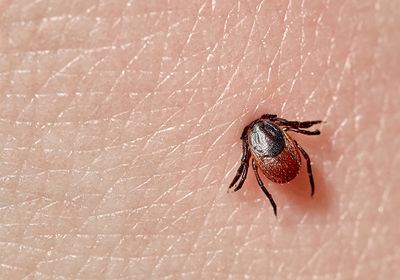ABOVE: Hard ticks can remain attached to the skin for days because of proteins in their saliva that help create a solid cone of saliva around their mouthparts. ©iStock, EvgeniyQ
Astealthy quest is afoot in the forests of the Netherlands. Sitting atop a blade of grass, biding time till its next blood meal, is a hard tick. It attaches to an exposed leg of an unsuspecting victim, digs into the skin, and starts feeding. The tick’s sticky, protein-rich saliva transforms into a solid cement cone to keep it fixed to the skin for days. This shape-shifting liquid is the tick bioadhesive.
Many other animals—mussels, sandcastle worms, and spiders—produce bioadhesives, but Siddharth Deshpande, a biophysicist at Wageningen University and Research, found himself stuck on the idea of studying tick glue.1 “Tick adhesive is incredibly unique in the sense that it is in direct contact with human skin. All the other bioadhesives basically stick to rocks or hard substrates, not living substrates,” said Deshpande.

However, not much was known about the adhesive mechanisms of tick saliva. Now, in a new study, Deshpande and his team described how phase transitions of a tick saliva protein contribute to the cement cone formation.2 “This is the first report in ticks about the physical chemistry behind their adhesion,” Deshpande said. These findings, published in Nature Chemistry, could guide the development of novel tick control strategies and the synthesis of improved tissue sealants for wound healing.
“It’s extremely exciting and validating to see how consistently this material overlaps with the behavior of other bioadhesives,” said David Breslauer, a material scientist and the chief technology officer at Bolt Threads, a company that produces bioengineered spider silk, who was not involved in the study.
Tick saliva is abundant in glycine-rich proteins (GRPs). Once the animal starts feeding on blood, the expression of GRPs in the saliva increases, possibly providing strength and insolubility to the cement cone.3 Glycine-rich regions can prevent protein folding, making them common in intrinsically disordered proteins, which do not have a stable three-dimensional structure. These proteins can flit between various conformations and establish multiple interactions with neighboring molecules, facilitating the concentration of biomolecules into microscopic droplets. The manifestation of such liquid condensates in a solution of biomolecules is called liquid-liquid phase separation (LLPS)—like when oil separates from water in a solution.4
Deshpande has been interested in phase separation for a long time. When he stumbled upon GRPs in tick saliva, Deshpande immediately thought that a solution of these proteins could phase separate. To validate his theory, he focused on a 77 amino acid-long GRP fragment (GRP77), of which 26 percent are glycine, in the hard tick Ixodes scapularis. AlphaFold predicted that GRP77 is highly disordered, making it an ideal candidate for LLPS. Deshpande and his colleagues used a simple assay to confirm this.
Phase separation is a concentration dependent process. A common experimental method to observe this phenomenon is the droplet evaporation assay, which is based on the coffee-ring effect—when a drop of coffee falls on the table, it evaporates to leave a concentrated dark ring of coffee sediments. Since the components in secreted tick saliva also undergo concentration via water loss, the team tested if a tiny drop of artificially synthesized fluorescent GRP77 solution showed phase separation when evaporated. Approximately 15 minutes after the researchers placed the drop on a glass surface, they observed intense fluorescence at the boundary of the droplet and the manifestation of a rim. Soon after, they saw the appearance of numerous micron-sized droplets rich in GRP77 floating in the dilute rim of buffer—a clear sign of LLPS. Deshpande was ecstatic to see them. “It’s not very often that what you thought happens in the first try,” he said.
Next, Deshpande and his colleagues mimicked some other LLPS-inducing features of tick saliva, notably the presence of salts. On adding phosphate salts to the protein droplet, they observed an immediate formation of GRP77 phase-separated condensates.
“I was pretty confident that the protein would undergo phase separation, but we were in for big surprises,” said Deshpande. On evaporating a droplet with high concentration of GRP77, he saw gel-like networks or, at times, stretched sheets under the microscope, which seemed like intermediate stages between liquid saliva and the solid cement cone.

To see if they could coax a more solid structure, the team let the protein and salt solution droplets dry for hours. When they saw the appearance of stable clusters, Deshpande wondered, "Okay, we are getting condensates, but are they sticky?” Turns out, the clusters were very sticky—they needed four orders of higher magnitude force to separate them from the surface, as compared to GRP77 condensates without any salts.
Lastly, the authors were curious to see if the natural saliva exhibits phase separation as well. After multiple trips to the local forest, dragging a cloth over the grass, they had enough ticks to extract a usable amount of saliva. A droplet evaporation assay revealed abundant spherical condensates that morphed into fiber-like structures on adding salt.
These findings are the first steps towards various potential developments, such as anti-tick vaccines and medical glues. “It makes a lot of sense to look at nature-based solutions instead of trying to invent bioadhesives,” said Romana Santos, a marine biologist at the University of Lisbon who researches sea urchin adhesion and was not involved in the study. “They’ve been working for animals for so long, why shouldn’t they work for us?” Santos is also curious to know how the tick detaches from the cement cone and the skin. “Barnacles and mussels also produce cement, and they live attached to the cement their whole life. But the tick can detach,” she said.
Deshpande now has his sights set on studying the behavior of other GRPs in tick saliva and how they might work together to form the cement cone. “This has really opened a completely new research field for me,” he said. “I am neither a tick researcher, nor a bioadhesion researcher, but now, suddenly I am.”
- Hennebert E, et al. Experimental strategies for the identification and characterization of adhesive proteins in animals: A review.Interface Focus. 2015;5(1):20140064.
- Ganar KA, et al. Phase separation and ageing of glycine-rich protein from tick adhesive.Nat Chem. 2024.
- Suppan J, et al. Tick attachment cement – reviewing the mysteries of a biological skin plug system.Biol Rev. 2018;93(2):1056-1076.
- Hyman AA, et al. Liquid-liquid phase separation in biology.Annu Rev Cell Dev Biol. 2014;30:39-58.




